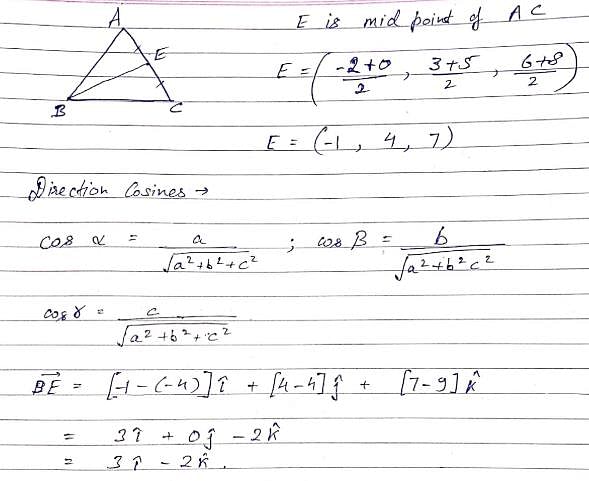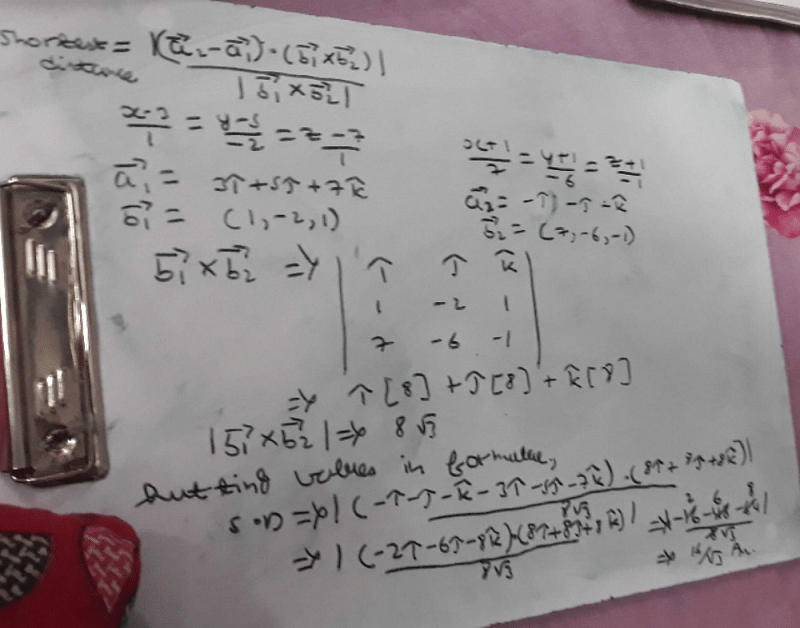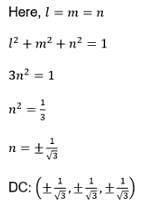All Exams >
Commerce >
Mathematics CUET Preparation >
All Questions
All questions of Chapter 11 - Three Dimensional Geometry for Commerce Exam
Find the equation of the set of points which are equidistant from the points (1, 2 , 3) and (3, 2, -1)
a) x + 2z = 0
b) y + 2z = 0
c) x – 2z = 0
d) x – 2y = 0
Correct answer is option 'C'. Can you explain this answer?
|
|
Aryan Khanna answered |
Pt. A(1, 2 , 3)
Pt. B(3, 2, -1)
Let P(x,y,z)
So, AP = BP
((x-1)2 + (y-2)2 + (z-3)2)1/2 = ((x-3)2 + (y-2)2 + (z+1)2)1/2
(x-1)2 + (y-2)2 + (z-3)2) = (x-3)2 + (y-2)2 + (z+1)2
x2 +1 -2x + y2 + 4 - 4y + z2 + 9 – 6z = x2 +9 -6x + y2 + 4 - 4y + z2 + 1 + 2z
4x – 8z = 0
x – 2z = 0
Pt. B(3, 2, -1)
Let P(x,y,z)
So, AP = BP
((x-1)2 + (y-2)2 + (z-3)2)1/2 = ((x-3)2 + (y-2)2 + (z+1)2)1/2
(x-1)2 + (y-2)2 + (z-3)2) = (x-3)2 + (y-2)2 + (z+1)2
x2 +1 -2x + y2 + 4 - 4y + z2 + 9 – 6z = x2 +9 -6x + y2 + 4 - 4y + z2 + 1 + 2z
4x – 8z = 0
x – 2z = 0
| 1 Crore+ students have signed up on EduRev. Have you? Download the App |
The signs of the X,Y and Z coordinates of a point that lies in the octant OXYZ’ is- a)(- , + , +)
- b)(-, – , +)
- c)( + , – , -)
- d)( + , + , -)
Correct answer is option 'D'. Can you explain this answer?
The signs of the X,Y and Z coordinates of a point that lies in the octant OXYZ’ is
a)
(- , + , +)
b)
(-, – , +)
c)
( + , – , -)
d)
( + , + , -)
|
|
Vikas Kapoor answered |
X,Y,Z imply positive X,Y,Z axis & X’,Y’,Z’ imply negative X,Y,Z axis.
So, OXYZ’ will have a point of signs (+, +, -).
So, OXYZ’ will have a point of signs (+, +, -).
The direction cosines of the line joining the points (2, -1, 8) and (-4, -3, 5) are:- a)

- b)

- c)

- d)

Correct answer is option 'B'. Can you explain this answer?
The direction cosines of the line joining the points (2, -1, 8) and (-4, -3, 5) are:
a)
b)
c)
d)
|
|
Geetika Shah answered |
Pt. A(2, -1, 8)
Pt. B(-4, -3, 5)
Direction Ratio DR of AB : ( -4-2 , -3+1 , 5-8 )
: (-6,-2,-3)
Direction cosine of AB : ( -6/(62+22+32)1/2 , -2/(62+22+32)1/2 , -3/(62+22+32)1/2)
: ( -6/7, -2/7, -3/7)
Pt. B(-4, -3, 5)
Direction Ratio DR of AB : ( -4-2 , -3+1 , 5-8 )
: (-6,-2,-3)
Direction cosine of AB : ( -6/(62+22+32)1/2 , -2/(62+22+32)1/2 , -3/(62+22+32)1/2)
: ( -6/7, -2/7, -3/7)
The angle between the lines x = 2y = – 3z and – 4x = 6y = – z is:- a)0°
- b)cos-1(1/√3)
- c)90°
- d)180°
Correct answer is option 'C'. Can you explain this answer?
The angle between the lines x = 2y = – 3z and – 4x = 6y = – z is:
a)
0°
b)
cos-1(1/√3)
c)
90°
d)
180°

|
Beyond the Horizon answered |
I cant find answer that matches option C... Is there some mistake in tje question?
If a line has the direction ratios -4, 18, -12 then what are its direction cosines?- a)-2, 9, -6
- b)-4, 18, -12
- c)2/11, 9/11, 6/11
- d)-2/11, 9/11, -6/11
Correct answer is option 'D'. Can you explain this answer?
If a line has the direction ratios -4, 18, -12 then what are its direction cosines?
a)
-2, 9, -6
b)
-4, 18, -12
c)
2/11, 9/11, 6/11
d)
-2/11, 9/11, -6/11
|
|
Vikas Kapoor answered |
DR of the line : (-4, 18 -12)
DC of the line : (-4/k, 18/k, -12/k)
where k = ((42) + (182) + (12)2)1/2
= (16 + 324 + 144)1/2
= (484)1/2
= 22
So, DC : (-4/22, 18/22, -12/22)
: (-2/11 , 9/11 , -6/11)
DC of the line : (-4/k, 18/k, -12/k)
where k = ((42) + (182) + (12)2)1/2
= (16 + 324 + 144)1/2
= (484)1/2
= 22
So, DC : (-4/22, 18/22, -12/22)
: (-2/11 , 9/11 , -6/11)
In the following case, determine whether the given planes are parallel or perpendicular, and in case they are neither, find the angles between them. 2x – 2y + 4z + 5 = 0 and 3x – 3y + 6z – 1 = 0- a)The planes are perpendicular
- b)The planes are parallel
- c)The planes are at 45∘
- d)The planes are at 55∘
Correct answer is option 'B'. Can you explain this answer?
In the following case, determine whether the given planes are parallel or perpendicular, and in case they are neither, find the angles between them. 2x – 2y + 4z + 5 = 0 and 3x – 3y + 6z – 1 = 0
a)
The planes are perpendicular
b)
The planes are parallel
c)
The planes are at 45∘
d)
The planes are at 55∘

|
Pranavi Iyer answered |
If a line makes angles 45°,150°, 135°, with x, y and z-axes respectively, find its direction cosines.- a)

- b)

- c)

- d)

Correct answer is option 'B'. Can you explain this answer?
If a line makes angles 45°,150°, 135°, with x, y and z-axes respectively, find its direction cosines.
a)
b)
c)
d)
|
|
Leelu Bhai answered |
Direction cosines of this line are cos 45, cos150 & cos135....i.e, 1/√2, -√3/2 & -1/√2
For which value of a lines  and
and  are perpendicular?
are perpendicular?
- a)11/70
- b)5
- c)1
- d)70/11
Correct answer is option 'B'. Can you explain this answer?
For which value of a lines  and
and  are perpendicular?
are perpendicular?
a)
11/70
b)
5
c)
1
d)
70/11
|
|
Tejas Verma answered |
(x-1)/(-3) = (y-2)/(2p/7) = (z-3)/2
(x-1)(-3p/7) = (y - 5)/1 = (z - 6)/(-5)
The direction ratio of the line are -3, 2p/7, -2 and (-3p)/7, 1, -5
Two lines with direction ratios, a1, b1, c1 and a2, b2, c2 are perpendicular to each other if a1a2 + b1b2 + c1c2 = 0
Therefore, (-3)(-3p/7) + (2p/7)(1) + 2(-5) = 0
(9p/7) + (2p/7) = 10
11p = 70
p = 70/1
(x-1)(-3p/7) = (y - 5)/1 = (z - 6)/(-5)
The direction ratio of the line are -3, 2p/7, -2 and (-3p)/7, 1, -5
Two lines with direction ratios, a1, b1, c1 and a2, b2, c2 are perpendicular to each other if a1a2 + b1b2 + c1c2 = 0
Therefore, (-3)(-3p/7) + (2p/7)(1) + 2(-5) = 0
(9p/7) + (2p/7) = 10
11p = 70
p = 70/1
Find the equation of the plane through the line of intersection of the planes x + y + z = 1 and 2x + 3y + 4z = 5 which is perpendicular to the plane x – y + z = 0.- a)x + z + 2 = 0
- b)– x – z + 2 = 0
- c)x – z + 2 = 0
- d)x + z + 5 = 0
Correct answer is option 'C'. Can you explain this answer?
Find the equation of the plane through the line of intersection of the planes x + y + z = 1 and 2x + 3y + 4z = 5 which is perpendicular to the plane x – y + z = 0.
a)
x + z + 2 = 0
b)
– x – z + 2 = 0
c)
x – z + 2 = 0
d)
x + z + 5 = 0

|
Avi Chawla answered |
The equation of the plane through the line of intersection of the planes







Equation of a plane which is at a distance d from the origin and the direction cosines of the normal to the plane are l, m, n is.- a)lx – my + nz = d
- b)– lx + my + nz = d
- c)lx + my + nz = d
- d)lx + my + nz = – d
Correct answer is option 'C'. Can you explain this answer?
Equation of a plane which is at a distance d from the origin and the direction cosines of the normal to the plane are l, m, n is.
a)
lx – my + nz = d
b)
– lx + my + nz = d
c)
lx + my + nz = d
d)
lx + my + nz = – d
|
|
Bhargavi Sen answered |
Equation of a Plane with Given Normal Vector
To find the equation of a plane in 3D space, we need a point on the plane and a normal vector to the plane. In this case, we are given the direction cosines of the normal vector and the distance of the plane from the origin.
Given Information:
- Direction cosines of the normal to the plane: l, m, n
- Distance of the plane from the origin: d
Equation of the Plane:
The general form of the equation of a plane in 3D space is:
lx + my + nz = d
Explanation:
- The direction cosines of the normal vector to the plane are l, m, n. This means that the coefficients of x, y, and z in the equation of the plane will be l, m, and n respectively.
- The distance of the plane from the origin is represented by the constant term d in the equation.
Correct Answer:
The correct equation of the plane in this case is:
lx + my + nz = d
Conclusion:
When given the direction cosines of the normal vector and the distance of the plane from the origin, the equation of the plane can be determined by using the general form lx + my + nz = d.
To find the equation of a plane in 3D space, we need a point on the plane and a normal vector to the plane. In this case, we are given the direction cosines of the normal vector and the distance of the plane from the origin.
Given Information:
- Direction cosines of the normal to the plane: l, m, n
- Distance of the plane from the origin: d
Equation of the Plane:
The general form of the equation of a plane in 3D space is:
lx + my + nz = d
Explanation:
- The direction cosines of the normal vector to the plane are l, m, n. This means that the coefficients of x, y, and z in the equation of the plane will be l, m, and n respectively.
- The distance of the plane from the origin is represented by the constant term d in the equation.
Correct Answer:
The correct equation of the plane in this case is:
lx + my + nz = d
Conclusion:
When given the direction cosines of the normal vector and the distance of the plane from the origin, the equation of the plane can be determined by using the general form lx + my + nz = d.
If l, m and n are the direction cosines of a line, Direction ratios of the line are the numbers which are- a)Proportional to the direction cosine l of the line
- b)Inversely Proportional to the direction cosines of the line
- c)Inversely Proportional to the direction cosine l of the line
- d)Proportional to the direction cosines of the line.
Correct answer is option 'D'. Can you explain this answer?
If l, m and n are the direction cosines of a line, Direction ratios of the line are the numbers which are
a)
Proportional to the direction cosine l of the line
b)
Inversely Proportional to the direction cosines of the line
c)
Inversely Proportional to the direction cosine l of the line
d)
Proportional to the direction cosines of the line.

|
Raksha Nambiar answered |
If l, m and n are the direction cosines of a line, Direction ratios of the line are the numbers which are Proportional to the direction cosines of the line.
If a line in the ZX-plane makes an angle 60o with Z-axis, the direction cosines of this line are:- a)

- b)

- c)

- d)

Correct answer is option 'A'. Can you explain this answer?
If a line in the ZX-plane makes an angle 60o with Z-axis, the direction cosines of this line are:
a)
b)
c)
d)

|
Saumya Gupta answered |
The angle between the line and z axis is 60 and the line in ZX plane so the angle between line and X axis is (90-60)=30 and line is perpendicular to Y axis so the angle between line and Y axis is 90. So direction cosine of line is cos30,cos90,cos60 =√3/2,0,1/2.
Direction: In the following questions, A statement of Assertion (A) is followed by a statement of Reason (R). Mark the correct choice asAssertion (A): P is a point on the line segment joining the points (3, 2, –1) and (6, –4, –2). If x coordinate of P is 5, then its y coordinate is –2.Reason (R): The two lines x = ay + b, z = cy + d and x = a’y + b’, z = c’y + d’ will be perpendicular, iff aa’ + bb’ + cc’ = 0.- a)Both A and R are true and R is the correct explanation of A
- b)Both A and R are true but R is NOT the correct explanation of A
- c)A is true but R is false
- d)A is false but R is True
Correct answer is option 'C'. Can you explain this answer?
Direction: In the following questions, A statement of Assertion (A) is followed by a statement of Reason (R). Mark the correct choice as
Assertion (A): P is a point on the line segment joining the points (3, 2, –1) and (6, –4, –2). If x coordinate of P is 5, then its y coordinate is –2.
Reason (R): The two lines x = ay + b, z = cy + d and x = a’y + b’, z = c’y + d’ will be perpendicular, iff aa’ + bb’ + cc’ = 0.
a)
Both A and R are true and R is the correct explanation of A
b)
Both A and R are true but R is NOT the correct explanation of A
c)
A is true but R is false
d)
A is false but R is True
|
|
Hansa Sharma answered |
Assertion (A) is correct.

Since P = (5, y, z)
Equation of line joining (3, 2, –1) and (6, –4, –2) is

so if point P lies on the line then it must satisfy the above equation

Hence y co-ordinate of P is –2.
Reason (R) is false.
Since, the two lines x = ay + b, z = cy + d and = a’y + b’, z = c’y + d’ will be perpendicular, iff aa’ + cc’ + 1 = 0.
The direction cosines of the line equally inclined with the axes, are:- a)1, 1, 1,
- b)0, 0, 0
- c)1/3, 1/3, 1/3
- d)1/√3, 1/√3, 1/√3
Correct answer is option 'D'. Can you explain this answer?
The direction cosines of the line equally inclined with the axes, are:
a)
1, 1, 1,
b)
0, 0, 0
c)
1/3, 1/3, 1/3
d)
1/√3, 1/√3, 1/√3
|
|
Geetika Mehta answered |
Direction cosines are the ratios of the direction ratios of a line. In other words, they represent the cosines of the angles that the line makes with the positive x, y, and z axes.
Let's consider a line equally inclined with the axes. This means that the line makes equal angles with each axis.
To find the direction cosines of this line, we need to determine the cosines of the angles it makes with the x, y, and z axes.
Let's assume that the line makes an angle of θ with each axis. Since the line is equally inclined with the axes, all the angles are equal.
Let's calculate the direction cosine along the x-axis:
cos(θ) = adjacent side / hypotenuse
cos(θ) = 1 / hypotenuse
hypotenuse = 1 / cos(θ)
Similarly, the direction cosine along the y-axis and z-axis would also be 1 / cos(θ).
Therefore, the direction cosines of the line equally inclined with the axes are (1 / cos(θ), 1 / cos(θ), 1 / cos(θ)).
Since the line is equally inclined with the axes, the angle θ is the same for all three direction cosines.
Hence, the correct answer is option D: 1/3, 1/3, 1/3.
Let's consider a line equally inclined with the axes. This means that the line makes equal angles with each axis.
To find the direction cosines of this line, we need to determine the cosines of the angles it makes with the x, y, and z axes.
Let's assume that the line makes an angle of θ with each axis. Since the line is equally inclined with the axes, all the angles are equal.
Let's calculate the direction cosine along the x-axis:
cos(θ) = adjacent side / hypotenuse
cos(θ) = 1 / hypotenuse
hypotenuse = 1 / cos(θ)
Similarly, the direction cosine along the y-axis and z-axis would also be 1 / cos(θ).
Therefore, the direction cosines of the line equally inclined with the axes are (1 / cos(θ), 1 / cos(θ), 1 / cos(θ)).
Since the line is equally inclined with the axes, the angle θ is the same for all three direction cosines.
Hence, the correct answer is option D: 1/3, 1/3, 1/3.
Find the distance of the point (0, 0, 0) from the plane 3x – 4y + 12 z = 3- a)9/13
- b)7/13
- c)5/13
- d)3/13
Correct answer is option 'D'. Can you explain this answer?
Find the distance of the point (0, 0, 0) from the plane 3x – 4y + 12 z = 3
a)
9/13
b)
7/13
c)
5/13
d)
3/13

|
Krish Ghoshal answered |
As we know that the length of the perpendicular from point
P(x1,y1,z1) from the plane a1x+b1y+c1z+d1 = 0 is given by:

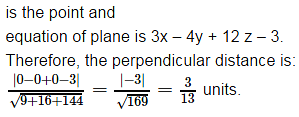
P(x1,y1,z1) from the plane a1x+b1y+c1z+d1 = 0 is given by:
If a1, b1, c1 and a2, b2, c2 are the direction ratios of two lines and θ is the acute angle between the two lines; then- a)

- b)

- c)

- d)

Correct answer is option 'A'. Can you explain this answer?
If a1, b1, c1 and a2, b2, c2 are the direction ratios of two lines and θ is the acute angle between the two lines; then
a)
b)
c)
d)

|
Amrutha Chaudhary answered |
If a1, b1, c1 and a2, b2, c2 are the direction ratios of two lines and θθ is the acute angle between the two lines; then , the cosine of the angle between these two lines is given by :

The equation of a plane through a point whose position vector is  perpendicular to the vector
perpendicular to the vector  . is
. is- a)

- b)

- c)

- d)

Correct answer is option 'C'. Can you explain this answer?
The equation of a plane through a point whose position vector is  perpendicular to the vector
perpendicular to the vector  . is
. is
a)
b)
c)
d)

|
Siddharth Chaudhary answered |
In vector form The equation of a plane through a point whose position vector is  perpendicular to the vector
perpendicular to the vector  Is given by :
Is given by : 
If l1, m1, n1 and l2, m2, n2 are the direction cosines of two lines; and θ is the acute angle between the two lines; then- a)

- b)

- c)

- d)

Correct answer is option 'B'. Can you explain this answer?
If l1, m1, n1 and l2, m2, n2 are the direction cosines of two lines; and θ is the acute angle between the two lines; then
a)
b)
c)
d)

|
Ipsita Sen answered |
If l1, m1, n1 and l2, m2, n2 are the direction cosines of two lines; and θ is the acute angle between the two lines; then the cosine of the angle between these two lines is given by :

Vector equation of a plane that passes through the intersection of planes  expressed in terms of a non – zero constant λ is
expressed in terms of a non – zero constant λ is- a)

- b)

- c)

- d)

Correct answer is option 'D'. Can you explain this answer?
Vector equation of a plane that passes through the intersection of planes  expressed in terms of a non – zero constant λ is
expressed in terms of a non – zero constant λ is
a)
b)
c)
d)

|
Nandita Basak answered |
In vector form:
Vector equation of a plane that passes through the intersection of planes
 expressed in terms of a non – zero constant λ is given by :
expressed in terms of a non – zero constant λ is given by :

Vector equation of a plane that passes through the intersection of planes
The vector and cartesian equations of the planes that passes through the point (1, 0, – 2) and the normal to the plane is 
- a)

- b)

- c)

- d)

Correct answer is option 'C'. Can you explain this answer?
The vector and cartesian equations of the planes that passes through the point (1, 0, – 2) and the normal to the plane is 
a)

b)

c)

d)


|
Aravind Nambiar answered |
Let
 be the position vector of the point
be the position vector of the point  here,
here,
 . Therefore, the required vector equation of the plane is:
. Therefore, the required vector equation of the plane is:

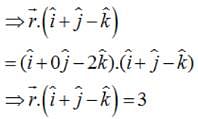
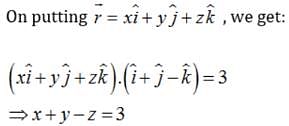
In the vector form, equation of a plane which is at a distance d from the origin, and  is the unit vector normal to the plane through the origin is
is the unit vector normal to the plane through the origin is- a)

- b)

- c)

- d)

Correct answer is option 'A'. Can you explain this answer?
In the vector form, equation of a plane which is at a distance d from the origin, and  is the unit vector normal to the plane through the origin is
is the unit vector normal to the plane through the origin is
a)
b)
c)
d)

|
Anuj Saini answered |
In the vector form, equation of a plane which is at a distance d from the origin, and  is the unit vector normal to the plane through the origin is given by :
is the unit vector normal to the plane through the origin is given by : 
Direction cosines of a line are- a)The tangents of the angles made by the line with the negative directions of the coordinate axes.
- b)The sines of the angles made by the line with the positive directions of the coordinate axes.
- c)The cotangents of the angles made by the line with the negative directions of the coordinate axes.
- d)The cosines of the angles made by the line with the positive directions of the coordinate axes.
Correct answer is option 'D'. Can you explain this answer?
Direction cosines of a line are
a)
The tangents of the angles made by the line with the negative directions of the coordinate axes.
b)
The sines of the angles made by the line with the positive directions of the coordinate axes.
c)
The cotangents of the angles made by the line with the negative directions of the coordinate axes.
d)
The cosines of the angles made by the line with the positive directions of the coordinate axes.

|
Mohit Patel answered |
Direction cosines of a line are the cosines of the angles made by the line with the positive direction of the coordinate axis.i.e. x- axis , y-axis and z – axis respectively.
Determine the direction cosines of the normal to the plane and the distance from the origin. Plane z = 2- a)0, 1, 0; 2
- b)1, 0, 0; 3
- c)1, 0, 1; 3
- d)0, 0, 1; 2
Correct answer is option 'D'. Can you explain this answer?
Determine the direction cosines of the normal to the plane and the distance from the origin. Plane z = 2
a)
0, 1, 0; 2
b)
1, 0, 0; 3
c)
1, 0, 1; 3
d)
0, 0, 1; 2

|
Saikat Dasgupta answered |
We have z = 2 . , it can be written as : 0x+0y+1z = 2. Compare it with lx+my+nz = d , we get ; l = 0 , m = 0 , n = 1 and d = 2 . therefore , D.C.’s of normal to the plane are 0 , 0 , 1 and distance from the origin = 2.
 is a vector joining two points P(x1, y1, z1) and Q(x2, y2, z2). If
is a vector joining two points P(x1, y1, z1) and Q(x2, y2, z2). If  Direction cosines of
Direction cosines of  are
are- a)

- b)

- c)

- d)

Correct answer is option 'C'. Can you explain this answer?
a)
b)
c)
d)

|
Aryan Sen answered |
Find the distance of the point (3, – 2, 1) from the plane 2x – y + 2z + 3 = 0- a)17/3
- b)19/3
- c)13/3
- d)15/3
Correct answer is option 'C'. Can you explain this answer?
Find the distance of the point (3, – 2, 1) from the plane 2x – y + 2z + 3 = 0
a)
17/3
b)
19/3
c)
13/3
d)
15/3

|
Siddharth Chaudhary answered |
As we know that the length of the perpendicular from point P(x1,y1,z1) from the plane
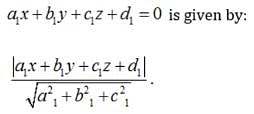
Here, P(3, - 2,1) is the point and equation of Plane is 2x - y + 2z+3 = 0

Here, P(3, - 2,1) is the point and equation of Plane is 2x - y + 2z+3 = 0
Therefore, the perpendicular distance is :


Find the equations of the planes that passes through three points (1, 1, 0), (1, 2, 1), (– 2, 2, – 1)- a)2x + 3y – 7z = 5
- b)2x + 5y – 3z = 5
- c)3x + 3y – 3z = 5
- d)2x + 3y – 3z = 5
Correct answer is option 'D'. Can you explain this answer?
Find the equations of the planes that passes through three points (1, 1, 0), (1, 2, 1), (– 2, 2, – 1)
a)
2x + 3y – 7z = 5
b)
2x + 5y – 3z = 5
c)
3x + 3y – 3z = 5
d)
2x + 3y – 3z = 5

|
Anand Khanna answered |
In cartesian co-ordinate system :
Equation of a plane passing through three non collinear
Equation of a plane passing through three non collinear
Points (x1, y1, z1) , (x2, y2, z2) and (x3, y3, z3) is given by :

Therefore, the equations of the planes that passes through three points (1,1,0), (1,2,1), (-2,2,-1) is given by :

⇒ (x-1)(-2) - (y-1) (3) + 3z = 0
⇒ 2x+3y - 3z = 5

Therefore, the equations of the planes that passes through three points (1,1,0), (1,2,1), (-2,2,-1) is given by :

⇒ (x-1)(-2) - (y-1) (3) + 3z = 0
⇒ 2x+3y - 3z = 5
Vector equation of a line that passes through the given point whose position vector is  and parallel to a given vector
and parallel to a given vector  is
is- a)

- b)

- c)

- d)

Correct answer is option 'B'. Can you explain this answer?
Vector equation of a line that passes through the given point whose position vector is  and parallel to a given vector
and parallel to a given vector  is
is
a)
b)
c)
d)

|
Subhankar Mukherjee answered |
Vector equation of a line that passes through the given point whose position vector is  and parallel to a given vector
and parallel to a given vector  is given by :
is given by : 
Find the values of p so that the lines  are at right angles.
are at right angles.- a)p =72/15
- b)p =70/11
- c)p =70/12
- d)p =71/13
Correct answer is option 'B'. Can you explain this answer?
Find the values of p so that the lines  are at right angles.
are at right angles.
a)
p =72/15
b)
p =70/11
c)
p =70/12
d)
p =71/13

|
Avantika Saha answered |
Give lines are :
 and
and 
The D.R's of the lines are -3, 2p/7, 2 and -3p/7, 1, -5


 and
and 
The D.R's of the lines are -3, 2p/7, 2 and -3p/7, 1, -5


What are direction numbers of a line.- a)numbers which are same as direction angles of a line
- b)numbers which are proportional to the direction angles of a line
- c)numbers which are proportional to the direction cosines of a line
- d)none
Correct answer is option 'C'. Can you explain this answer?
What are direction numbers of a line.
a)
numbers which are same as direction angles of a line
b)
numbers which are proportional to the direction angles of a line
c)
numbers which are proportional to the direction cosines of a line
d)
none
|
|
Madhurima Reddy answered |
The numbers which are proportional to direction cosines of a line are called direction numbers of the line.
If l, m, n are the direction cosines and a, b, c are the direction ratios of a line then- a)

- b)

- c)

- d)

Correct answer is option 'C'. Can you explain this answer?
If l, m, n are the direction cosines and a, b, c are the direction ratios of a line then
a)

b)

c)

d)


|
Avantika Saha answered |
If l, m, n are the direction cosines and a, b, c are the direction ratios of a line then , the directions cosines of the line are given by :


Find the shortest distance between the lines : 


- a)

- b)

- c)

- d)

Correct answer is option 'D'. Can you explain this answer?
Find the shortest distance between the lines : 




a)
b)
c)
d)

|
Ritika Kulkarni answered |
On comparing the given equations with: 
, we get:
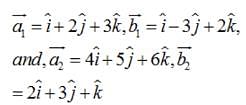




, we get:




Direction: In the following questions, A statement of Assertion (A) is followed by a statement of Reason (R). Mark the correct choice asAssertion (A): The angle between the straight lines  Reason (R): Skew lines are lines in different planes which are parallel and intersecting.
Reason (R): Skew lines are lines in different planes which are parallel and intersecting.- a)Both A and R are true and R is the correct explanation of A
- b)Both A and R are true but R is NOT the correct explanation of A
- c)A is true but R is false
- d)A is false but R is True
Correct answer is option 'C'. Can you explain this answer?
Direction: In the following questions, A statement of Assertion (A) is followed by a statement of Reason (R). Mark the correct choice as
Assertion (A): The angle between the straight lines
 Reason (R): Skew lines are lines in different planes which are parallel and intersecting.
Reason (R): Skew lines are lines in different planes which are parallel and intersecting.a)
Both A and R are true and R is the correct explanation of A
b)
Both A and R are true but R is NOT the correct explanation of A
c)
A is true but R is false
d)
A is false but R is True
|
|
Hansa Sharma answered |
Assertion (A) is correct.



Direction ratios of lines are a1 = 2, b1 = 5, c1 = 4 and a2 = 1, b2 = 2, c2 = –3
As we know, The angle between the lines is given by


= 0
∴ θ = 90°
Reason (R) is wrong.
In the space, there are lines neither intersecting nor parallel, such pairs of lines are non-coplanar and are called skew lines.
Three planes, viz the XY Plane, XZ Plane and the YZ Plane divide the space into eight parts. Each part is called an OCTANT. What is the relation between these three planes- a)They form the angles α, β & γ with each other
- b)Any two must be perpendicular to each other.
- c)All three are mutually perpendicular
- d)no relation between these three planes
Correct answer is option 'C'. Can you explain this answer?
Three planes, viz the XY Plane, XZ Plane and the YZ Plane divide the space into eight parts. Each part is called an OCTANT. What is the relation between these three planes
a)
They form the angles α, β & γ with each other
b)
Any two must be perpendicular to each other.
c)
All three are mutually perpendicular
d)
no relation between these three planes
|
|
Janani Pillai answered |
The three mutually perpendicular coordinate planes which in turn divide the space into eight parts and each part is known as octant.
A line makes angles α, β, γ with the positive directions of X-axis, Y-axis and Z-axis, respectively, then the directions cosines of the line are:- a)180° - α, 180° - β, 180° - γ
- b)cos - α, cos - β, cos - γ
- c)90° - α, 90° - β, 90° - γ
- d)sin α, sin β, sin γ
Correct answer is option 'B'. Can you explain this answer?
A line makes angles α, β, γ with the positive directions of X-axis, Y-axis and Z-axis, respectively, then the directions cosines of the line are:
a)
180° - α, 180° - β, 180° - γ
b)
cos - α, cos - β, cos - γ
c)
90° - α, 90° - β, 90° - γ
d)
sin α, sin β, sin γ
|
|
Bhargavi Bose answered |
cos α, cos β, cos γ
By the definition of Direction Cosines
By the definition of Direction Cosines
Determine the direction cosines of the normal to the plane and the distance from the origin. Plane x + y + z = 1- a)

- b)

- c)

- d)

Correct answer is option 'A'. Can you explain this answer?
Determine the direction cosines of the normal to the plane and the distance from the origin. Plane x + y + z = 1
a)
b)
c)
d)

|
Prasenjit Malik answered |
Here , D.R’s of normal to the plane are 1, 1 , 1 ,its D.C ‘s are :

On dividing x + y + z = 1 by √3 , we get :
 It is of the form : lx+my+nz = d , therefore , d = 1/√3 .
It is of the form : lx+my+nz = d , therefore , d = 1/√3 .
On dividing x + y + z = 1 by √3 , we get :
Distance between 
- a)

- b)

- c)

- d)

Correct answer is option 'A'. Can you explain this answer?
Distance between 
a)
b)
c)
d)

|
Aryan Sen answered |
In vector form Distance between two parallel lines  given by :
given by :

If a line makes angles 90∘, 135∘, 45∘ with the x, y and z – axes respectively, find its direction cosines.- a)

- b)

- c)

- d)

Correct answer is option 'A'. Can you explain this answer?
If a line makes angles 90∘, 135∘, 45∘ with the x, y and z – axes respectively, find its direction cosines.
a)
b)
c)
d)

|
Pranav Pillai answered |
If a line makes angles 90∘, 135∘, 45∘ with the x, y and z – axes respectively, then the direction cosines of this line is given by :
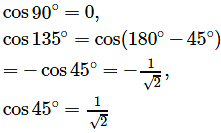
Shortest distance between the lines 
- a)

- b)

- c)

- d)

Correct answer is option 'A'. Can you explain this answer?
Shortest distance between the lines
a)
b)
c)
d)

|
Saikat Dasgupta answered |
In Cartesian coordinate system Shortest distance between the lines

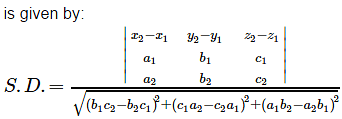
Chapter doubts & questions for Chapter 11 - Three Dimensional Geometry - Mathematics CUET Preparation 2024 is part of Commerce exam preparation. The chapters have been prepared according to the Commerce exam syllabus. The Chapter doubts & questions, notes, tests & MCQs are made for Commerce 2024 Exam. Find important definitions, questions, notes, meanings, examples, exercises, MCQs and online tests here.
Chapter doubts & questions of Chapter 11 - Three Dimensional Geometry - Mathematics CUET Preparation in English & Hindi are available as part of Commerce exam.
Download more important topics, notes, lectures and mock test series for Commerce Exam by signing up for free.
Mathematics CUET Preparation
153 videos|65 docs|110 tests
|
Signup to see your scores go up within 7 days!
Study with 1000+ FREE Docs, Videos & Tests
10M+ students study on EduRev
|
Free Exam Preparation
at your Fingertips!
Access Free Study Material - Test Series, Structured Courses, Free Videos & Study Notes and Prepare for Your Exam With Ease

 Join the 10M+ students on EduRev
Join the 10M+ students on EduRev
|

|
Forgot Password
OR
Signup to see your scores
go up within 7 days!
Access 1000+ FREE Docs, Videos and Tests
Takes less than 10 seconds to signup
